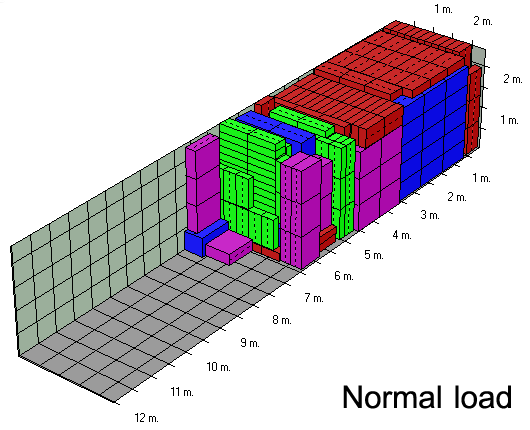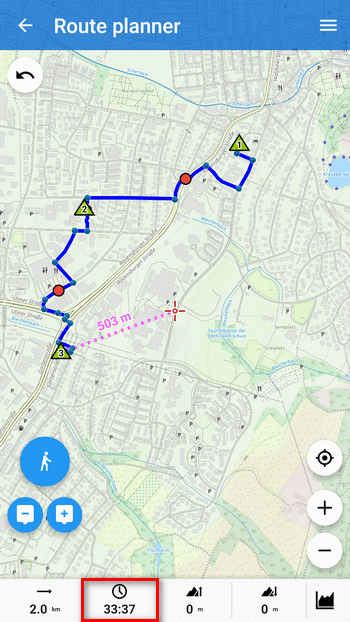Major Concerns of Retail Logistics Software
Retail logistics software is a vast topic that can be analyzed as a group of subdomains including but not limited to:
- Container and pallet loading software
- Last mile logistics solutions
- Parcel software
This post will cover the challenges facing these three realms, including solutions that already exist as well as logistics management software still lacking in the market.
Container and Pallet Loading System
To optimize a container or a pallet loading, a company must choose one pallet loading pattern from a variety of choices that can differ based on the type of loading products, their volume, and size.

Many out-of-the-box and fully optimized pallet loading solutions can help companies reduce their packaging, transportation, and storage costs.
For instance, Logen Solutions claims a 5-20% reduction of the number of truck or container loads, as well as a 20% reduction to other associated costs.
The key problem is that the incorporation of ready-made software into the business workflow can be challenging.
Secondly, most of these tools primarily focus on volume utilization, but stability maintenance of packs on a pallet remains unaddressed.
Lastly, too few ready-to-use solutions can automatically identify pallet loading inefficiencies.
Pallet Loading: Benefits of Customized Solutions
There are a variety of companies that offer tailored tools subject to different constraints.
For instance, Innovecs has experience in automating hotspot area detection and can help logistics companies deliver their own solutions.
With the help of image recognition, Innovecs’ tailor-made software can alert users on spots with incorrect loading or where boxes are placed inefficiently.

Usage example. Palletizing by distribution centers differs from the manufacturer’s experience. The latter is likely to load pallets with identical boxes, but distributors, instead, take non-identical parcels. This means that the distributor’s pallet loading software must utilize the pallet volume efficiently while also taking into consideration weight and stability constraints.

Tailor-made solutions can allow companies to take into account a variety of input data like:
- Fragility
- Weight distribution
- Drop constraints
- The number of pallets needed
- Requirements to the storage conditions
- Other input parameters
In addition, tailor-made solutions become an option for companies that need to incorporate new pallet loading modules into their existing ERP and warehouse management systems.
Last Mile Delivery Software
Retail logistics software serving the supply chain differs depending on the delivery stage.
Mainly, this is due to the difference in delivery method during the first, the middle, and the last mile. First-mile delivery is served primarily by trucks. This stage assumes much less delivery turnover, longer distances, and the fewer number of loading and unloading processes.
The lack of similarities between the serving companies, types of business processes, and even ways of the service arrangement leads to the necessity of the unique software for every delivery stage.
As for parcel software, carriers usually choose either ready-to-use or customary software based on the scopes of their requirements. If there are no out-of-the-box solutions that fit the company’s needs, they turn to software development companies to deliver a custom tool.
Last-Mile Problem: Benefits of Customized Retail Solutions
Most companies requiring tailored last mile delivery software need a high level of visibility and predictivity. These companies would like to not only control drivers and the delivery status in real time but predict when this stage will be over.
Usage example. Since last mile delivery is associated with driving across urban areas, traffic jams need to be taken into consideration while mapping the delivery route. Although ready-to-use solutions can solve this challenge, carriers usually need to install another app for this. “When a driver has to think about which app to use for delivery, there is less chance of compliance and more chance of error as they aren’t familiar with every app they are asked to use,” believes Mr.Bramlett.

Innovecs has leveraged its experience to design a platform that can:
• automatically identify arrival and departure time subject to the traffic constraints,
• monitor the route,
• alert the weather risks, and
• update delivery statuses.
Parcel Software
Every year, the value of parcel shipments grows by 11%. According to the Pitney Bowes Parcel Shipping Index, in 2017, 13 major countries generated almost $280 billion in parcel revenue.

What drives the development of this domain?
First, e-commerce, with $2.8 trillion of sales in 2018, has become one of the most significant drivers for the growth of the parcels’ number.
Secondly, the advancement of key carriers has entirely upgraded parcel shipment.
Lastly, once big players, like Amazon or Alibaba, enter new markets, these markets demonstrate considerable improvement.
In the wake of this trend, demand on parcel software from the side of retailers, manufacturers, and end consumers becomes more obvious.
Parcel shipping software helps manufacturers, distributors, logistics companies, mail order houses, or any other company that distributes up to thousands of parcels daily to manage their parcel delivery.

End consumers need parcel delivery software for visibility of their orders, prediction of the delivery time, and the possibility to change any input data at any delivery stage.
One of the best examples of ready-to-use parcel audit software is Dispatch Science. This software optimizes the parcel delivery process for both carriers and customers. For carriers, it helps maximize the number of deliveries while also saving time and fuel. For customers, the software allows tracking deliveries and makes updates at different stages of the delivery process.
“Regardless if it’s a custom or a ready-made product, it still needs the implementation requirements. This means the necessity to review the existing processes that are in place, question the challenges, and adapt the product accordingly. However, when it comes to out-of-the-box solutions, usually companies choose a one that fits their business processes the most. This allows dismissing the implementation challenges,” says Mr. Axelrad regarding the process of choosing ready-made parcel shipping software by carriers.
Parcel Shipping Software: Benefits of Customized Solutions
Usually, custom parcel software is needed by companies that demand a variety of features to be implemented at once and there are no suitable ready-made tools.
Secondly, providers that serve software development can help with the integration of new solutions into the existing company’s ecosystem.
Usage example. When it comes to parcel management software, the requirements of this software from the perspective of carriers and customers differ.
Carriers need to analyze trends on top of big data to predict spikes in volume in certain areas. Such information can help grant more drivers and properly plan the workload.
Logistics companies know that, for example, every second Thursday of a month they have increased activity in the east city in the late afternoon. In this case, they are likely to provide more drivers for this area instead of leaving it empty.
Customers need parcel tracking software to predict when a parcel will be delivered to their place.
What Retail Logistics Software Solutions to Use?
There are no recommendations to either use an exact ready-made solution or to develop a unique logistics management software.
Why?
The best option depends on the specific task and the requirements for a solution.
In general, there is a shift towards out-of-the-box solutions, but the major challenge is to find a tool that best fits the company’s requirements.
Since many ready-made solutions have a narrow focus, logistics companies that need to overcome a variety of different challenges must use a few tools at once. To add integration requirements like separate customer modules, integration of payments, or gateways, custom software for complex infrastructure becomes a necessity.
Here, at Innovecs, we are vastly experienced in serving different types of companies across the logistics industry.
Innovecs’ clients include but are not limited to:
• US Cold, where Innovecs is revamping their warehouse management system
• A US-based company that requires the development of a transportation management system from scratch
• A provider of supply chain management apps for end-to-end visibility, risk management, planning, order automation, and multi-enterprise collaboration
If you are looking to benefit from a custom logistics tracking software and desire a partner in this transformation journey, Innovecs is here to help. Just drop us a line to move forward.